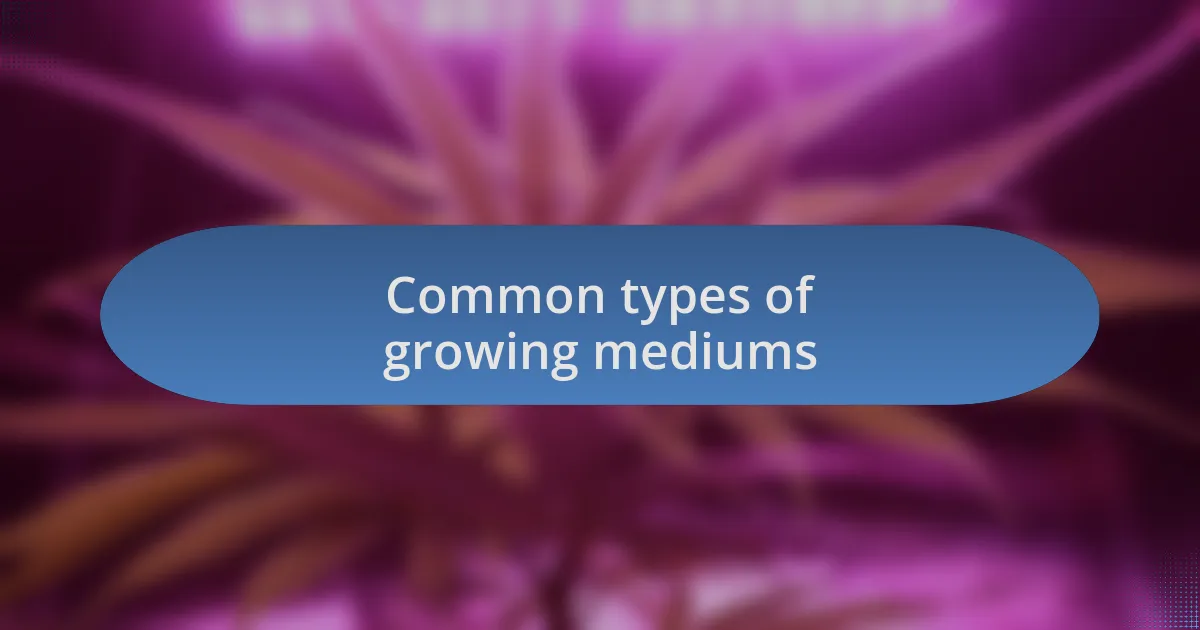Key takeaways:
- Choosing the right growing medium is vital and can differ for each grower based on personal experience and the specific needs of the cannabis strain.
- Common mediums include soil for its organic richness, soilless mixes for drainage and air retention, and hydroponics for precise nutrient control.
- Factors such as nutrient availability, environmental conditions, and the medium’s properties significantly influence plant growth and yield.
- Experimentation and careful observation of plant responses help identify the most effective growing mediums and practices.

Understanding growing mediums
When I first started my journey in cannabis cultivation, I was overwhelmed by the sheer variety of growing mediums available. A growing medium is essentially the material in which your plants grow, providing them with the essential nutrients and support they need. From soil to soilless mixes and hydroponics, each type has its own unique characteristics that can significantly affect your plants’ growth and health.
Reflecting on my own experience, I found that the choice of medium can feel like a personal relationship; some growers just click with soil, while others thrive on the precision of hydroponics. I remember my initial hesitation with Coco Coir—at first, I thought it would not retain enough moisture. However, once I adapted my approach, its excellent drainage and air retention transformed my growing experience. How does one find the right medium? It often takes trial and error, and what works miracles for one grower might be a struggle for another.
As I continued to explore different mediums, I realized that understanding their properties could be a game-changer. Each medium affects aspects like nutrient availability and root health in distinct ways. Have you ever watched a plant flourish in a medium you weren’t initially sure about? It’s a reminder that sometimes, the best discoveries come from stepping outside our comfort zones.

Common types of growing mediums
When it comes to common types of growing mediums, soil is often the first choice for many cannabis growers. It’s rich in organic matter and promotes a lively ecosystem of beneficial microbes. I clearly remember my initial success with a high-quality organic soil blend—plants seemed to flourish almost overnight, and watching them thrive was one of the most rewarding feelings in my early growing days.
Soilless mixes, like Coco Coir and perlite, have become popular as they offer excellent drainage while still retaining moisture. In my experience with Coco Coir, I discovered that it’s not just about the moisture levels; the ability to create an airy environment for roots transformed my approach. I often found myself wondering, how do such slight tweaks make such a big difference? The truth is, the more I experimented, the more I realized that the choice of growing medium can be as personal as selecting a favorite recipe.
Hydroponics, while often seen as complex, offers precise control over nutrient delivery, which can lead to faster growth rates. When I first ventured into hydroponic systems, I was surprised by how quickly my plants responded to the nutrient solution. It was exhilarating to witness, but it did come with its own challenges. Have you ever felt the thrill of a system working seamlessly, only to be hit by a sudden imbalance? Navigating that learning curve taught me just how vital it is to understand each medium deeply.

Factors influencing medium selection
Selecting a growing medium is influenced by various factors, primarily the specific needs of the cannabis strain you’re cultivating. I remember choosing a variety that thrived in a moisture-retentive environment but later discovered that the medium’s drainage properties were just as crucial. It made me ponder: how could such a small detail dramatically affect growth and yield? The compatibility between strain and medium is critical.
Nutrient availability is another significant element to consider. When I started out, I underestimated how a medium could affect nutrient absorption. A shift to a nutrient-rich soilless mix opened my eyes to the importance of this factor—it was like turning on the lights in a dim room. Have you ever experienced a sudden burst of growth after optimizing your medium? That realization truly changed my whole approach to growing.
Environmental factors, such as humidity and temperature, also play a vital role in medium selection. During one growing season, I opted for a medium that provided insulation during colder months, and it turned out to be a game-changer. The slight adjustments to maintain optimal conditions prompted me to ask: how could I overlook such pivotal aspects of my growing environment? Each choice in your medium not only influences growth but also defines your growing journey.

Applying knowledge to my garden
When it came time to apply my knowledge to my garden, I found that experimentation was key. I remember setting up a small test section where I switched out different mediums to see how each affected my plants. Watching one strain flourish in a cocoa-based mix while another thrived in a peat blend taught me how responsive plants can be to their environment. Have you ever been surprised by what your plants can tell you?
I also learned that observation is just as critical as selection. There was a moment when I neglected to monitor my pH levels while using a new mix, and the results were eye-opening. The plants reacted swiftly to the imbalance, which led me to take a step back and reassess my entire approach. That experience reminded me how interconnected every aspect of gardening is. Have you ever made a mistake that turned into a valuable lesson?
Embracing new knowledge transformed my planting routine. I began documenting specific metrics like moisture retention and nutrient content, which became invaluable references for future grows. By keeping a journal of my findings, I not only tracked improvements but also built a richer understanding of what my garden needed. Isn’t it fascinating how a little data can lead to significant breakthroughs?